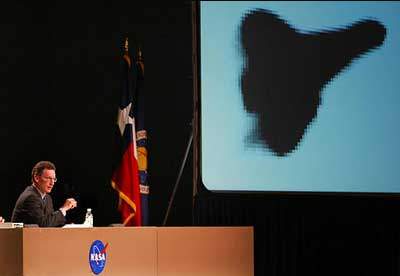Management Reported To Be Big Factor In Columbia Tragedy
 The NASA management culture
contributed as much as anything else to the Columbia
shuttle tragedy. That's the word from retired Admiral Harold
Gehman, chairman of the Columbia Accident Investigation
Board.
The NASA management culture
contributed as much as anything else to the Columbia
shuttle tragedy. That's the word from retired Admiral Harold
Gehman, chairman of the Columbia Accident Investigation
Board.
"A goodly portion of the report, perhaps half, is going to deal
with the issue of management and management techniques," Gehman
said last week. "We will not tell NASA how to organize ... but we
will tell them what needs to be done," Gehman said at a
briefing.
The CAIB's report to the president, Congress and all
of America is due out before August. Members have already
attributed the disintegration of the shuttle Columbia to a
chunk of insulating foam which fell off the orbiter's external fuel
tank and impacted its left wing, 82 seconds after liftoff. The
resulting damage to Columbia's wing is blamed for allowing
super-heated gases past the carbon-carbon surface and inside the
wing structure itself, melting vital structural components and
causing the shuttle to break apart over Texas and Louisiana. All
seven astronauts were killed in the Feb. 1 disaster.
"Missed Signals, Bureaucratic Fumbling"
 NASA Administrator Sean
O'Keefe has spent the past week trying to brace his team for what
he expects to be a blistering CAIB report. He may not be wrong.
Board members have been critical of what they see as danger signals
overlooked by space agency management, bureaucratic fumbling that
contributed to the Columbia disaster. "It's not just the
foam that NASA has to do something about," Gehman told reporters.
Among the major criticisms from the CAIB: NASA denied heated
requests from engineers studying the foam impact who wanted to turn
spy satellite cameras on the wounded shuttle. The NSA, which
operates those satellites, even offered its assistance. Again, NASA
managers said "no."
NASA Administrator Sean
O'Keefe has spent the past week trying to brace his team for what
he expects to be a blistering CAIB report. He may not be wrong.
Board members have been critical of what they see as danger signals
overlooked by space agency management, bureaucratic fumbling that
contributed to the Columbia disaster. "It's not just the
foam that NASA has to do something about," Gehman told reporters.
Among the major criticisms from the CAIB: NASA denied heated
requests from engineers studying the foam impact who wanted to turn
spy satellite cameras on the wounded shuttle. The NSA, which
operates those satellites, even offered its assistance. Again, NASA
managers said "no."
Criticism of NASA's corporate culture isn't confined
to the CAIB. Even as Columbia was in orbit on its final,
doomed mission, Allen Li at the General Accounting Office (the
investigative branch of Congress), wrote a stinging assessment of
the shuttle program in particular and the space agency in general.
The report listed several "challenges" facing NASA which the
authors believed could threaten the agency's ability to manage
programs like the shuttle missions. "Because they are rooted in
NASA's culture and long-standing ways of doing business, NASA will
need to make a major transformation," the summary said.

The report also suggested:
- Retaining NASA's best workers and doing more to attract new
ones to replace those who leave.
- Controlling costs for the $95 billion International Space
Station.
- Cutting the expense of launches; on the shuttle, it costs about
$10,000 per pound (0.45 kg) to put objects in space, while NASA
once aimed to launch for one-tenth that amount aboard an
as-yet-undesigned new launch vehicle.
- Improving the way NASA manages its contracts. Outsourcing
accounts for as much as 85 percent of NASA's budget.
But the CAIB report will supposedly take a much differenct
track, blaming part of the problems that led to the
Columbia disaster on budget cuts -- and spreading that
blame throughout NASA, Congress -- all the way up to the White
House. NASA, according to a draft CAIB report, can't continue to
launch such frequent and ambitious missions without proper funding.
Either the missions should be drawn back, the CAIB will reportedly
say, or Washington will have to cough up more dough for the
shuttle program.
 ANN's Daily Aero-Linx (04.16.24)
ANN's Daily Aero-Linx (04.16.24) Aero-News: Quote of the Day (04.16.24)
Aero-News: Quote of the Day (04.16.24) Airborne 04.10.24: SnF24!, A50 Heritage Reveal, HeliCycle!, Montaer MC-01
Airborne 04.10.24: SnF24!, A50 Heritage Reveal, HeliCycle!, Montaer MC-01 Airborne 04.12.24: SnF24!, G100UL Is Here, Holy Micro, Plane Tags
Airborne 04.12.24: SnF24!, G100UL Is Here, Holy Micro, Plane Tags Airborne-Flight Training 04.17.24: Feds Need Controllers, Spirit Delay, Redbird
Airborne-Flight Training 04.17.24: Feds Need Controllers, Spirit Delay, Redbird





